Transformer架构:手撸源码实践
1. 引言
Transformer架构自2017年在论文《Attention Is All You Need》中被提出以来,彻底改变了自然语言处理(NLP)领域。它摒弃了传统的循环神经网络(RNN)和卷积神经网络(CNN),完全基于注意力机制构建,成为现代大语言模型(如BERT、GPT系列)的基础架构。
本文将深入解析Transformer的核心组件,通过手写实现代码来帮助理解其内部工作机制。
2. Transformer整体架构
Transformer采用经典的编码器-解码器架构:
输入序列 → 编码器 → 解码器 → 输出序列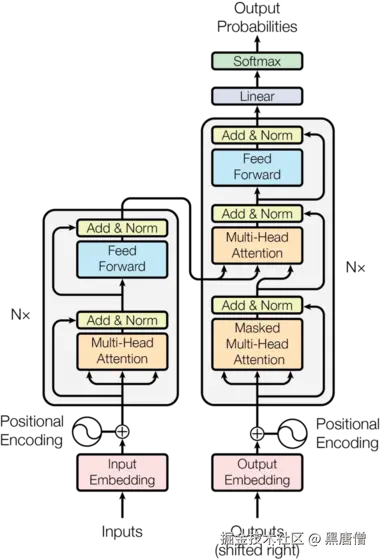
2.1 编码器(Encoder)
编码器由6个相同的层堆叠而成,每层包含两个子层:
- 多头自注意力机制(Multi-Head Self-Attention)
- 位置前馈网络(Position-wise Feed-Forward Networks)
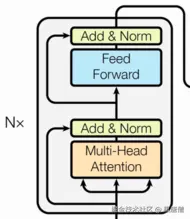 每层都使用残差连接和层归一化。
每层都使用残差连接和层归一化。
编码器可以表示为以下公式:
<math xmlns="http://www.w3.org/1998/Math/MathML"> E n c L a y e r ( x ) = L a y e r N o r m ( x + S e l f A t t e n t i o n ( x ) ) \mathrm{EncLayer}(x) = \mathrm{LayerNorm}(x + \mathrm{SelfAttention}(x)) </math>EncLayer(x)=LayerNorm(x+SelfAttention(x))
<math xmlns="http://www.w3.org/1998/Math/MathML"> E n c L a y e r ( x ) = L a y e r N o r m ( x + F F N ( x ) ) \mathrm{EncLayer}(x) = \mathrm{LayerNorm}(x + \mathrm{FFN}(x)) </math>EncLayer(x)=LayerNorm(x+FFN(x))
完整的编码器层可以表示为:
<math xmlns="http://www.w3.org/1998/Math/MathML"> E n c o d e r L a y e r ( x ) = L a y e r N o r m ( L a y e r N o r m ( x + S e l f A t t e n t i o n ( x ) ) + F F N ( L a y e r N o r m ( x + S e l f A t t e n t i o n ( x ) ) ) ) \mathrm{EncoderLayer}(x) = \mathrm{LayerNorm}(\mathrm{LayerNorm}(x + \mathrm{SelfAttention}(x)) + \mathrm{FFN}(\mathrm{LayerNorm}(x + \mathrm{SelfAttention}(x)))) </math>EncoderLayer(x)=LayerNorm(LayerNorm(x+SelfAttention(x))+FFN(LayerNorm(x+SelfAttention(x))))
2.2 解码器(Decoder)
解码器也由6个相同的层堆叠而成,每层包含三个子层:
- 掩码多头自注意力机制(Masked Multi-Head Self-Attention)
- 编码器-解码器注意力机制(Encoder-Decoder Attention)
- 位置前馈网络(Position-wise Feed-Forward Networks)
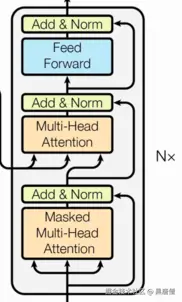 同样,每层都使用残差连接和层归一化。
同样,每层都使用残差连接和层归一化。
解码器层可以表示为以下公式:
<math xmlns="http://www.w3.org/1998/Math/MathML"> D e c L a y e r ( x , e n c o u t ) = L a y e r N o r m ( x + M a s k e d S e l f A t t e n t i o n ( x ) ) \mathrm{DecLayer}(x, enc_out) = \mathrm{LayerNorm}(x + \mathrm{MaskedSelfAttention}(x)) </math>DecLayer(x,encout)=LayerNorm(x+MaskedSelfAttention(x))
<math xmlns="http://www.w3.org/1998/Math/MathML"> D e c L a y e r ( x , e n c o u t ) = L a y e r N o r m ( x + E n c o d e r A t t e n t i o n ( x , e n c o u t ) ) \mathrm{DecLayer}(x, enc_out) = \mathrm{LayerNorm}(x + \mathrm{EncoderAttention}(x, enc_out)) </math>DecLayer(x,encout)=LayerNorm(x+EncoderAttention(x,encout))
<math xmlns="http://www.w3.org/1998/Math/MathML"> D e c L a y e r ( x , e n c o u t ) = L a y e r N o r m ( x + F F N ( x ) ) \mathrm{DecLayer}(x, enc_out) = \mathrm{LayerNorm}(x + \mathrm{FFN}(x)) </math>DecLayer(x,encout)=LayerNorm(x+FFN(x))
3. 核心组件详解
3.1 注意力机制(Attention)
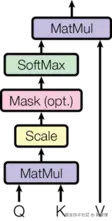
注意力机制是Transformer的核心,其数学表达式为:
<math xmlns="http://www.w3.org/1998/Math/MathML"> Attention ( Q , K , V ) = softmax ( Q K T d k ) V \text{Attention}(Q, K, V) = \text{softmax}\left(\frac{QK^T}{\sqrt{d_k}}\right)V </math>Attention(Q,K,V)=softmax(dk QKT)V
其中:
- Q(Query):查询向量
- K(Key):键向量
- V(Value):值向量
- <math xmlns="http://www.w3.org/1998/Math/MathML"> d k d_k </math>dk:键向量的维度
缩放因子 <math xmlns="http://www.w3.org/1998/Math/MathML"> 1 d k \frac{1}{\sqrt{d_k}} </math>dk 1的作用是为了防止点积结果过大导致softmax函数梯度消失。
在我们的实现中,注意力机制的代码如下:
python
def attention(q, k, v, mask=None, dropout=None):
"""
计算注意力机制
Args:
q: 查询矩阵 [batch_size, heads, seq_len, d_k]
k: 键矩阵 [batch_size, heads, seq_len, d_k]
v: 值矩阵 [batch_size, heads, seq_len, d_k]
mask: 掩码矩阵,用于屏蔽某些位置
dropout: dropout层
Returns:
tuple: (注意力输出, 注意力权重)
"""
# 自注意力公式三步走
# 第一步: q* k的转置除以根号d_k
# 第二部: 判断是否做掩码, softmax层计算
# 第三部: 乘以V
# [batch_size, sqen_len, embed_dim]
embed_dim = k.size(-1)
# 计算Q和K的点积 [batch_size, heads, seq_len, seq_len]
q_k = torch.matmul(q, k.transpose(-1,-2)) # batch_size, sqen_len, sqen_len
# 缩放点积,除以根号d_k,防止梯度消失
attn_weight = q_k / math.sqrt(embed_dim)
if mask is not None:
# 使用mask屏蔽不需要关注的位置,将被屏蔽位置的权重设为极小值
attn_weight = attn_weight.masked_fill(mask == 0, -1e9)
# 对注意力权重进行softmax归一化
attn_weight = nn.functional.softmax(attn_weight, dim=-1)
if dropout is not None:
# 应用dropout防止过拟合
attn_weight = dropout(attn_weight)
# 使用注意力权重对V进行加权求和
res = torch.matmul(attn_weight , v)
return res, attn_weight3.2 多头注意力(Multi-Head Attention)
为了增强模型捕捉不同位置信息的能力,Transformer使用多头注意力机制:
<math xmlns="http://www.w3.org/1998/Math/MathML"> MultiHead ( Q , K , V ) = Concat ( head 1 , . . . , head h ) W O \text{MultiHead}(Q, K, V) = \text{Concat}(\text{head}_1, ..., \text{head}_h)W^O </math>MultiHead(Q,K,V)=Concat(head1,...,headh)WO
其中每个头计算为: <math xmlns="http://www.w3.org/1998/Math/MathML"> head i = Attention ( Q W i Q , K W i K , V W i V ) \text{head}_i = \text{Attention}(QW_i^Q, KW_i^K, VW_i^V) </math>headi=Attention(QWiQ,KWiK,VWiV)
多头注意力机制允许模型在不同表示子空间中并行关注信息,增强了模型的表达能力。
MultiHead计算的完整过程可以表示为:
<math xmlns="http://www.w3.org/1998/Math/MathML"> M u l t i H e a d ( Q , K , V ) = C o n c a t ( h e a d 1 , . . . , h e a d h ) W O \mathrm{MultiHead}(Q, K, V) = \mathrm{Concat}(\mathrm{head_1}, ..., \mathrm{head_h})W^O </math>MultiHead(Q,K,V)=Concat(head1,...,headh)WO
<math xmlns="http://www.w3.org/1998/Math/MathML"> where h e a d i = A t t e n t i o n ( Q W i Q , K W i K , V W i V ) \text{where} \quad \mathrm{head_i} = \mathrm{Attention}(QW_i^Q, KW_i^K, VW_i^V) </math>whereheadi=Attention(QWiQ,KWiK,VWiV)
多头注意力机制结构图
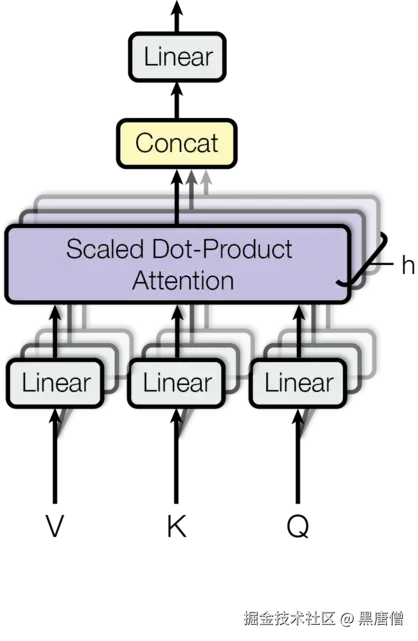
python
class MultiHeadAttention(nn.Module):
"""
多头注意力机制
将输入分割为多个头,分别计算注意力,然后合并结果
"""
def __init__(self, heads, embed_dim, dropout_p=0.1):
"""
初始化多头注意力
Args:
heads: 注意力头的数量
embed_dim: 嵌入维度
dropout_p: dropout概率
"""
super().__init__()
# 构建属性
self.heads = heads
self.embed_dim = embed_dim
# 确保嵌入维度可以被头数整除
assert embed_dim % heads == 0
# 计算每个头的维度
self.d_k = embed_dim // heads
# 构建4个线性层: 3个用于Q、K、V的线性变换,1个用于最终输出
self.linears = clone_modules(nn.Linear(embed_dim, embed_dim), 4)
# 实例化dropout
self.dropout = nn.Dropout(dropout_p)
def forward(self, q, k, v, mask=None):
"""
前向传播
Args:
q: 查询 [batch_size, seq_len, embed_dim]
k: 键 [batch_size, seq_len, embed_dim]
v: 值 [batch_size, seq_len, embed_dim]
mask: 掩码矩阵
Returns:
torch.Tensor: 多头注意力输出
"""
if mask is not None:
# 扩展mask的维度以匹配多头
mask = mask.unsqueeze(0)
batch_size = q.size(0)
heads = self.heads
embed_dim = q.size(-1)
d_k = self.d_k
# 拆分多头序列 + 做线性变换
# 对Q、K、V分别应用线性变换,然后reshape为(batch_size, heads, seq_len, d_k)
q, k, v = [linear(x)
.view(batch_size, -1, heads, d_k)
.transpose(1,2)
for linear,x in zip(self.linears,(q,k,v))]
# 获取注意力机制输出
output, attn_weight = attention(q, k, v, mask, self.dropout)
# 合并多头到一个量中
# 交换维度并合并heads和d_k维度
res = output.transpose(1,2).contiguous().view(batch_size, -1, embed_dim)
# 最后使用线性层做收尾处理
return self.linears[-1](res)3.3 位置编码(Positional Encoding)
由于自注意力机制本身不包含位置信息,Transformer引入位置编码来为模型提供序列中词的位置信息。
Transformer使用正弦和余弦函数生成位置编码:
<math xmlns="http://www.w3.org/1998/Math/MathML"> P E ( p o s , 2 i ) = sin ( p o s 1000 0 2 i / d model ) PE_{(pos,2i)} = \sin\left(\frac{pos}{10000^{2i/d_{\text{model}}}}\right) </math>PE(pos,2i)=sin(100002i/dmodelpos)
<math xmlns="http://www.w3.org/1998/Math/MathML"> P E ( p o s , 2 i + 1 ) = cos ( p o s 1000 0 2 i / d model ) PE_{(pos,2i+1)} = \cos\left(\frac{pos}{10000^{2i/d_{\text{model}}}}\right) </math>PE(pos,2i+1)=cos(100002i/dmodelpos)
其中:
- <math xmlns="http://www.w3.org/1998/Math/MathML"> p o s pos </math>pos 是位置
- <math xmlns="http://www.w3.org/1998/Math/MathML"> i i </math>i 是维度
- <math xmlns="http://www.w3.org/1998/Math/MathML"> d model d_{\text{model}} </math>dmodel 是模型维度
这种设计使得模型能够学习到相对位置信息,因为对于任意固定的偏移 <math xmlns="http://www.w3.org/1998/Math/MathML"> k k </math>k, <math xmlns="http://www.w3.org/1998/Math/MathML"> P E p o s + k PE_{pos+k} </math>PEpos+k 可以表示为 <math xmlns="http://www.w3.org/1998/Math/MathML"> P E p o s PE_{pos} </math>PEpos 的线性函数。
位置编码的完整公式可以表示为:
<math xmlns="http://www.w3.org/1998/Math/MathML"> P E ( p o s , 2 i ) = sin ( p o s 1000 0 2 i / d model ) PE_{(pos,2i)} = \sin\left(\frac{pos}{10000^{2i/d_{\text{model}}}}\right) </math>PE(pos,2i)=sin(100002i/dmodelpos)
<math xmlns="http://www.w3.org/1998/Math/MathML"> P E ( p o s , 2 i + 1 ) = cos ( p o s 1000 0 2 i / d model ) PE_{(pos,2i+1)} = \cos\left(\frac{pos}{10000^{2i/d_{\text{model}}}}\right) </math>PE(pos,2i+1)=cos(100002i/dmodelpos)
python
class PositionalEmbedding(nn.Module):
"""
位置编码层
为序列中每个位置生成独特的编码,使模型能够利用序列顺序信息
"""
def __init__(self, max_length, embed_dim, dropout_p=0.1):
"""
初始化位置编码层
Args:
max_length: 序列最大长度
embed_dim: 嵌入维度
dropout_p: dropout概率
"""
super().__init__()
self.max_length = max_length
self.embed_dim = embed_dim
# Dropout层用于防止过拟合
self.dropout = nn.Dropout(p=dropout_p)
# 创建位置编码矩阵 [max_length, embed_dim]
pe = torch.zeros(max_length, embed_dim) # [60, 512]
# 生成位置信息 [max_length, 1]
pos = torch.arange(0, max_length).unsqueeze(1) # [60, 1] = [[0],[1],[2], ...[59]]
# 生成维度索引 0, 2, 4, ..., embed_dim-2 (只取偶数索引)
tow_i = torch.arange(0, embed_dim, 2) # [256] = 0 2 4 6 8 .. 510 , 一共256个数
# 计算角度频率参数
tmp_v = torch.exp((math.log(10000) * -tow_i / self.embed_dim)) # [256]
# 计算角度值:pos * 角度频率
fn_v = tmp_v * pos # [256] * [60, 1]
# 偶数位置使用sin编码
pe[:, 0::2] = torch.sin(fn_v)
# 奇数位置使用cos编码
pe[:, 1::2] = torch.cos(fn_v)
# 增加batch维度 [1, max_length, embed_dim]
pe = pe.unsqueeze(0) # [1, 60, 512]
# 注册为buffer,不会被更新,但会随模型保存和加载
self.register_buffer('pe', pe)
def forward(self, x): # 输入形状:[batch_size, seq_len, embed_dim]
"""
前向传播
Args:
x: 输入张量 [batch_size, seq_len, embed_dim]
Returns:
torch.Tensor: 加入位置编码的张量 [batch_size, seq_len, embed_dim]
"""
# 截取与输入序列长度相等的位置编码
p_x = self.pe[:, :x.size(1)] # [1, seq_len, embed_dim]
# 将位置编码与输入相加,并应用dropout
res = self.dropout(p_x + x) # [batch_size, seq_len, embed_dim]
return res3.4 词嵌入与缩放(Embedding and Scaling)
Transformer中的Embedding层负责将离散的词汇转换为连续向量表示。为了保持数值稳定性,Transformer在词嵌入后进行缩放操作:
<math xmlns="http://www.w3.org/1998/Math/MathML"> Embedding scaled = Embedding × d model \text{Embedding}{\text{scaled}} = \text{Embedding} \times \sqrt{d{\text{model}}} </math>Embeddingscaled=Embedding×dmodel
词嵌入缩放的目的是平衡词嵌入和位置编码的数值范围,确保两者在数值上处于相近的量级,有助于模型训练的稳定性。
python
class Embeddings(nn.Module):
"""
词嵌入层
将词汇索引转换为密集向量表示
"""
def __init__(self, input_size, embed_dim):
"""
初始化词嵌入层
Args:
input_size: 词汇表大小
embed_dim: 嵌入维度
"""
super().__init__()
self.embed_dim = embed_dim
# 创建嵌入层,将input_size个单词映射到embed_dim维向量
self.embed = nn.Embedding(input_size, embedding_dim=embed_dim)
def forward(self, x):
"""
前向传播
Args:
x: 输入张量,包含词汇索引 [batch_size, seq_len]
Returns:
torch.Tensor: 词嵌入向量 [batch_size, seq_len, embed_dim]
"""
# 通过嵌入层获取向量表示,并除以sqrt(embed_dim)进行缩放
# 这种缩放有助于稳定梯度,特别是在位置编码加入之后
return self.embed(x) / math.sqrt(self.embed_dim)3.5 层归一化(Layer Normalization)
层归一化用于稳定训练过程,加速收敛。其数学公式为:
<math xmlns="http://www.w3.org/1998/Math/MathML"> μ = 1 H ∑ i = 1 H x i \mu = \frac{1}{H}\sum_{i=1}^{H} x_i </math>μ=H1∑i=1Hxi
<math xmlns="http://www.w3.org/1998/Math/MathML"> σ 2 = 1 H ∑ i = 1 H ( x i − μ ) 2 \sigma^2 = \frac{1}{H}\sum_{i=1}^{H} (x_i - \mu)^2 </math>σ2=H1∑i=1H(xi−μ)2
<math xmlns="http://www.w3.org/1998/Math/MathML"> y = x − μ σ 2 + ϵ ⊙ γ + β y = \frac{x - \mu}{\sqrt{\sigma^2 + \epsilon}} \odot \gamma + \beta </math>y=σ2+ϵ x−μ⊙γ+β
其中:
- <math xmlns="http://www.w3.org/1998/Math/MathML"> μ \mu </math>μ 是均值
- <math xmlns="http://www.w3.org/1998/Math/MathML"> σ 2 \sigma^2 </math>σ2 是方差
- <math xmlns="http://www.w3.org/1998/Math/MathML"> ϵ \epsilon </math>ϵ 是一个小常数,防止除零
- <math xmlns="http://www.w3.org/1998/Math/MathML"> γ \gamma </math>γ 和 <math xmlns="http://www.w3.org/1998/Math/MathML"> β \beta </math>β 是可学习的缩放和偏移参数
层归一化的完整计算过程可以表示为:
<math xmlns="http://www.w3.org/1998/Math/MathML"> L a y e r N o r m ( x ) = x − μ σ 2 + ϵ ⊙ γ + β \mathrm{LayerNorm}(x) = \frac{x - \mu}{\sqrt{\sigma^2 + \epsilon}} \odot \gamma + \beta </math>LayerNorm(x)=σ2+ϵ x−μ⊙γ+β
python
class LayerNorm(nn.Module):
"""
层归一化
对每个样本的特征进行归一化,而不是对批次维度进行归一化
"""
def __init__(self, embed_dim, eps=1e-6):
"""
初始化层归一化
Args:
embed_dim: 嵌入维度
eps: 防止除零的小值
"""
super().__init__()
# 创建可学习的缩放参数W,初始化为全1矩阵
self.w = nn.Parameter(torch.ones(embed_dim))
# 创建可学习的偏移参数B,初始化为全0矩阵
self.b = nn.Parameter(torch.zeros(embed_dim))
# 防止除零的小值
self.eps = eps
def forward(self, x):
"""
前向传播
Args:
x: 输入张量 [batch_size, seq_len, embed_dim]
Returns:
torch.Tensor: 归一化后的张量
"""
# 计算平均数
x_mean = torch.mean(x, keepdim=True, dim=-1) # keepdim=True , 保持形状一致
# 计算标准差
x_std = torch.std(x, keepdim=True, dim=-1)
# 计算 (x-平均数) / (标准差+eps) = 标准化后的x
res = (x - x_mean) / (x_std + self.eps) # 修正了原代码中的运算符优先级问题
# 返回 W * x + b,应用可学习的缩放和偏移
return self.w * res + self.b3.6 前馈神经网络(Feed-Forward Networks)
前馈网络对每个位置的表示进行非线性变换。其数学公式为:
<math xmlns="http://www.w3.org/1998/Math/MathML"> F F N ( x ) = max ( 0 , x W 1 + b 1 ) W 2 + b 2 \mathrm{FFN}(x) = \max(0, xW_1 + b_1)W_2 + b_2 </math>FFN(x)=max(0,xW1+b1)W2+b2
其中:
- <math xmlns="http://www.w3.org/1998/Math/MathML"> W 1 ∈ R d m o d e l × d f f W_1 \in \mathbb{R}^{d_{model} \times d_{ff}} </math>W1∈Rdmodel×dff 和 <math xmlns="http://www.w3.org/1998/Math/MathML"> W 2 ∈ R d f f × d m o d e l W_2 \in \mathbb{R}^{d_{ff} \times d_{model}} </math>W2∈Rdff×dmodel 是参数矩阵
- <math xmlns="http://www.w3.org/1998/Math/MathML"> b 1 b_1 </math>b1 和 <math xmlns="http://www.w3.org/1998/Math/MathML"> b 2 b_2 </math>b2 是偏置向量
- <math xmlns="http://www.w3.org/1998/Math/MathML"> d f f = 2048 d_{ff} = 2048 </math>dff=2048 是前馈网络的隐藏层维度
前馈网络的完整计算过程可以表示为:
<math xmlns="http://www.w3.org/1998/Math/MathML"> F F N ( x ) = R e L U ( x W 1 + b 1 ) W 2 + b 2 \mathrm{FFN}(x) = \mathrm{ReLU}(xW_1 + b_1)W_2 + b_2 </math>FFN(x)=ReLU(xW1+b1)W2+b2
python
class FeedForward(nn.Module):
"""
前馈神经网络
在Transformer中用于对每个位置的表示进行非线性变换
"""
def __init__(self, embed_dim, hidden_size=2048, dropout_p = 0.1):
"""
初始化前馈网络
Args:
embed_dim: 嵌入维度
hidden_size: 隐藏层大小,默认为2048
dropout_p: dropout概率
"""
super().__init__()
# 两个线性层, 外加ReLU激活函数和dropout随机失活
# 第一个线性层将维度从embed_dim扩展到hidden_size
self.linear1 = nn.Linear(embed_dim, hidden_size)
# ReLU激活函数
self.relu = nn.ReLU()
# Dropout层用于防止过拟合
self.dropout = nn.Dropout(p=dropout_p)
# 第二个线性层将维度从hidden_size压缩回embed_dim
self.linear2 = nn.Linear(hidden_size, embed_dim)
def forward(self, x):
"""
前向传播
Args:
x: 输入张量 [batch_size, seq_len, embed_dim]
Returns:
torch.Tensor: 前馈网络输出
"""
# 第一层线性变换
x = self.linear1(x)
# ReLU激活
x = self.relu(x)
# Dropout防止过拟合
x = self.dropout(x)
# 第二层线性变换
x = self.linear2(x)
return x3.7 子层连接(Sublayer Connection)
子层连接实现残差连接和层归一化。其数学公式为:
<math xmlns="http://www.w3.org/1998/Math/MathML"> S u b l a y e r ( x ) = L a y e r N o r m ( x + S u b l a y e r ( x ) ) \mathrm{Sublayer}(x) = \mathrm{LayerNorm}(x + \mathrm{Sublayer}(x)) </math>Sublayer(x)=LayerNorm(x+Sublayer(x))
其中Sublayer(x)可以是自注意力层或前馈网络层。
子层连接的完整计算过程可以表示为:
<math xmlns="http://www.w3.org/1998/Math/MathML"> S u b l a y e r C o n n e c t i o n ( x , S u b l a y e r ) = L a y e r N o r m ( x + D r o p o u t ( S u b l a y e r ( x ) ) ) \mathrm{SublayerConnection}(x, \mathrm{Sublayer}) = \mathrm{LayerNorm}(x + \mathrm{Dropout}(\mathrm{Sublayer}(x))) </math>SublayerConnection(x,Sublayer)=LayerNorm(x+Dropout(Sublayer(x)))
python
class SubLayers(nn.Module):
"""
子层连接模块
实现残差连接和层归一化
"""
def __init__(self, embed_dim, dropout_p=0.1):
"""
初始化子层连接
Args:
embed_dim: 嵌入维度
dropout_p: dropout概率
"""
super().__init__()
# 实例化层归一化函数
self.norm = LayerNorm(embed_dim)
# Dropout层
self.dropout = nn.Dropout(p=dropout_p)
def forward(self, x, layer_fn):
"""
前向传播
Args:
x: 输入张量
layer_fn: 要应用的层函数(如注意力层或前馈网络)
Returns:
torch.Tensor: 经过残差连接和层归一化的输出
"""
# 对输入应用指定的层函数,然后进行层归一化和dropout
# 最后与原始输入进行残差连接(x + res)
res = self.dropout(self.norm(layer_fn(x)))
return x + res4. 编码器实现
编码器由多个编码器层堆叠而成:
编码器层的完整计算过程可以表示为:
<math xmlns="http://www.w3.org/1998/Math/MathML"> E n c o d e r L a y e r ( x ) = S u b l a y e r C o n n e c t i o n ( S u b l a y e r C o n n e c t i o n ( x , S e l f A t t e n t i o n ) , F F N ) \mathrm{EncoderLayer}(x) = \mathrm{SublayerConnection}(\mathrm{SublayerConnection}(x, \mathrm{SelfAttention}), \mathrm{FFN}) </math>EncoderLayer(x)=SublayerConnection(SublayerConnection(x,SelfAttention),FFN)
编码器的完整计算过程可以表示为:
<math xmlns="http://www.w3.org/1998/Math/MathML"> E n c o d e r ( x ) = L a y e r N o r m ( E n c o d e r L a y e r N ( ⋯ ( E n c o d e r L a y e r 1 ( x ) ) ⋯ ) ) \mathrm{Encoder}(x) = \mathrm{LayerNorm}(\mathrm{EncoderLayer}_N(\cdots(\mathrm{EncoderLayer}_1(x))\cdots)) </math>Encoder(x)=LayerNorm(EncoderLayerN(⋯(EncoderLayer1(x))⋯))
python
class EncoderLayer(nn.Module):
"""
编码器层
包含自注意力层和前馈神经网络层
"""
def __init__(self, embed_dim, heads, dropout_p=0.1, hidden_size=2048):
"""
初始化编码器层
Args:
embed_dim: 嵌入维度
heads: 注意力头数
dropout_p: dropout概率
hidden_size: 前馈网络隐藏层大小
"""
super().__init__()
# 多头自注意力机制
self.multi_head_attn = MultiHeadAttention(heads=heads, embed_dim=embed_dim, dropout_p=dropout_p)
# 前馈神经网络
self.feed_ward = FeedForward(embed_dim=embed_dim, hidden_size=hidden_size, dropout_p=dropout_p)
# 两个子层连接模块:自注意力和前馈网络
self.layers = clone_modules(SubLayers(embed_dim=embed_dim, dropout_p=dropout_p), N=2)
def forward(self, x, mask=None):
"""
前向传播
Args:
x: 输入张量 [batch_size, seq_len, embed_dim]
mask: 掩码张量,用于屏蔽无效位置
Returns:
torch.Tensor: 编码器层输出
"""
# 第一层:自注意力机制
x = self.layers[0](x, lambda x: self.multi_head_attn(x, x, x, mask))
# 第二层:前馈神经网络
x = self.layers[1](x, self.feed_ward)
return x
class Encoder(nn.Module):
"""
编码器
由多个编码器层堆叠组成
"""
def __init__(self, embed_dim, layer, N):
"""
初始化编码器
Args:
embed_dim: 嵌入维度
layer: 编码器层模板
N: 编码器层数
"""
super().__init__()
# 克隆N个相同的编码器层
self.encoder_layers = clone_modules(layer, N)
# 输出层归一化
self.norm = LayerNorm(embed_dim=embed_dim)
def forward(self, x, mask=None):
"""
前向传播
Args:
x: 输入张量 [batch_size, seq_len, embed_dim]
mask: 掩码张量
Returns:
torch.Tensor: 编码器输出
"""
# 依次通过每个编码器层
for layer in self.encoder_layers:
x = layer(x, mask=mask)
# 最终层归一化
res = self.norm(x)
return res5. 解码器实现
5.1 解码器实现
解码器也由多个解码器层堆叠而成,但结构比编码器更复杂:
解码器层的完整计算过程可以表示为:
<math xmlns="http://www.w3.org/1998/Math/MathML"> D e c o d e r L a y e r ( x , e n c o u t ) = S u b l a y e r C o n n e c t i o n ( S u b l a y e r C o n n e c t i o n ( S u b l a y e r C o n n e c t i o n ( x , M a s k e d S e l f A t t e n t i o n ) , E n c o d e r A t t e n t i o n ) , F F N ) \mathrm{DecoderLayer}(x, enc_out) = \mathrm{SublayerConnection}(\mathrm{SublayerConnection}(\mathrm{SublayerConnection}(x, \mathrm{MaskedSelfAttention}), \mathrm{EncoderAttention}), \mathrm{FFN}) </math>DecoderLayer(x,encout)=SublayerConnection(SublayerConnection(SublayerConnection(x,MaskedSelfAttention),EncoderAttention),FFN)
解码器的完整计算过程可以表示为:
<math xmlns="http://www.w3.org/1998/Math/MathML"> D e c o d e r ( x , e n c o u t ) = L a y e r N o r m ( D e c o d e r L a y e r N ( ⋯ ( D e c o d e r L a y e r 1 ( x , e n c o u t ) ) ⋯ ) ) \mathrm{Decoder}(x, enc_out) = \mathrm{LayerNorm}(\mathrm{DecoderLayer}_N(\cdots(\mathrm{DecoderLayer}_1(x, enc_out))\cdots)) </math>Decoder(x,encout)=LayerNorm(DecoderLayerN(⋯(DecoderLayer1(x,encout))⋯))
python
class DecoderLayer(nn.Module):
"""
解码器层
包含自注意力层、编码器-解码器注意力层和前馈网络
"""
def __init__(self, embed_dim, heads, feed_forward_hidden_size, dropout_p=0.1):
"""
初始化解码器层
Args:
embed_dim: 嵌入维度
heads: 注意力头数
feed_forward_hidden_size: 前馈网络隐藏层大小
dropout_p: dropout概率
"""
super().__init__()
# 第一个自注意力机制:目标序列的自注意力(需要掩码)
self.multi_head_attn = MultiHeadAttention(heads=heads, embed_dim=embed_dim, dropout_p=dropout_p)
# 三个子层连接模块:自注意力、编码器-解码器注意力、前馈网络
self.layers = clone_modules(SubLayers(embed_dim=embed_dim, dropout_p=dropout_p), N=3)
# 前馈神经网络
self.feed_forward = FeedForward(embed_dim=embed_dim, dropout_p=dropout_p, hidden_size=feed_forward_hidden_size)
def forward(self, q, k, v, target_mask=None, source_mask=None):
"""
前向传播
Args:
q: 查询向量(目标序列)
k: 键向量(编码器输出)
v: 值向量(编码器输出)
target_mask: 目标序列掩码(防止未来信息泄露)
source_mask: 源序列掩码
Returns:
torch.Tensor: 解码器层输出
"""
# 第一层:目标序列的自注意力(使用target_mask防止看到未来信息)
res_1 = self.layers[0](q, lambda x: self.multi_head_attn(x, x, x, target_mask))
# 第二层:编码器-解码器注意力(查询来自前一层,键值来自编码器输出)
res_2 = self.layers[1](res_1, lambda x: self.multi_head_attn(x, k, v, source_mask))
# 第三层:前馈神经网络
res_3 = self.layers[2](res_2, self.feed_forward)
return res_3
class Decoder(nn.Module):
"""
解码器
由多个解码器层堆叠而成
"""
def __init__(self, embed_dim, decoder_layer, n):
"""
初始化解码器
Args:
embed_dim: 嵌入维度
decoder_layer: 解码器层模板
n: 解码器层数
"""
super().__init__()
# 输出层归一化
self.norm = LayerNorm(embed_dim=embed_dim)
# 克隆N个解码器层
self.encoder_layers = clone_modules(decoder_layer, n)
def forward(self, q, k, v, target_mask=None, source_mask=None):
"""
前向传播
Args:
q: 查询向量(目标序列)
k: 键向量(编码器输出)
v: 值向量(编码器输出)
target_mask: 目标序列掩码
source_mask: 源序列掩码
Returns:
torch.Tensor: 解码器输出
"""
# 初始输入为查询向量
res = q
# 依次通过每个解码器层
for layer in self.encoder_layers:
res = layer(q, k, v, target_mask, source_mask)
# 最终层归一化
res = self.norm(res)
return res5.2输出部分介绍
输出部分包含: * 线性层 * softmax层
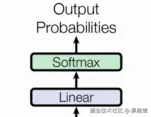
5.2.1 线性层的作用
- 通过对上一步的线性变化得到指定维度的输出, 也就是转换维度的作用.
5.2.2 softmax层的作用
- 使最后一维的向量中的数字缩放到0-1的概率值域内, 并满足他们的和为1.
5.2.3 线性层和softmax层的代码分析
ruby
# 解码器类 Generator 实现思路分析
# init函数 (self, d_model, vocab_size)
# 定义线性层self.project
# forward函数 (self, x)
# 数据 F.log_softmax(self.project(x), dim=-1)
class Generator(nn.Module):
def __init__(self, d_model, vocab_size):
# 参数d_model 线性层输入特征尺寸大小
# 参数vocab_size 线层输出尺寸大小
super(Generator, self).__init__()
# 定义线性层
self.project = nn.Linear(d_model, vocab_size)
def forward(self, x):
# 数据经过线性层 最后一个维度归一化 log方式
x = F.log_softmax(self.project(x), dim=-1)
return x- nn.Linear演示:
ini
>>> m = nn.Linear(20, 30)
>>> input = torch.randn(128, 20)
>>> output = m(input)
>>> print(output.size())
torch.Size([128, 30])6. 完整Transformer模型
将编码器和解码器组合成完整的Transformer模型:
完整的Transformer模型可以表示为:
<math xmlns="http://www.w3.org/1998/Math/MathML"> T r a n s f o r m e r ( X , Y ) = D e c o d e r ( E n c o d e r ( X ) , Y ) \mathrm{Transformer}(X, Y) = \mathrm{Decoder}(\mathrm{Encoder}(X), Y) </math>Transformer(X,Y)=Decoder(Encoder(X),Y)
python
class MyTransform(nn.Module):
"""
Transformer模型实现
包含编码器和解码器两部分
"""
def __init__(self, heads, embed_dim, feed_hidden_size, dropout_p=0.1):
"""
初始化Transformer模型
Args:
heads: 注意力头数
embed_dim: 嵌入维度
feed_hidden_size: 前馈网络隐藏层大小
dropout_p: dropout概率
"""
super().__init__()
# 创建编码器层模板
encoder_layer = EncoderLayer(heads=heads, embed_dim=embed_dim,
hidden_size=feed_hidden_size, dropout_p=dropout_p)
# 创建包含6层的编码器
self.encoder = Encoder(layer=encoder_layer, N=6, embed_dim=embed_dim)
# 创建解码器层模板
decoder_layer = DecoderLayer(heads=heads, embed_dim=embed_dim,
feed_forward_hidden_size=feed_hidden_size, dropout_p=dropout_p)
# 创建包含6层的解码器
self.decoder = Decoder(decoder_layer=decoder_layer, n=6, embed_dim=embed_dim)
def forward(self, x, y, target_mask, source_mask):
"""
前向传播
Args:
x: 源序列输入 [batch_size, src_seq_len, embed_dim]
y: 目标序列输入 [batch_size, tgt_seq_len, embed_dim]
target_mask: 目标序列掩码(防止未来信息泄露)
source_mask: 源序列掩码
Returns:
torch.Tensor: 解码器输出 [batch_size, tgt_seq_len, embed_dim]
"""
# 编码器处理源序列
encoder_output = self.encoder(x, source_mask)
# 解码器处理目标序列,使用编码器输出作为键和值
decoder_output = self.decoder(y, encoder_output, encoder_output, target_mask)
return decoder_output7. 公式与代码实现对照详解
为了更好地理解Transformer中各公式的实现,我们在此详细对照每个重要公式与其对应的代码实现。
7.1 注意力机制公式对照
注意力机制的核心公式:
<math xmlns="http://www.w3.org/1998/Math/MathML"> Attention ( Q , K , V ) = softmax ( Q K T d k ) V \text{Attention}(Q, K, V) = \text{softmax}\left(\frac{QK^T}{\sqrt{d_k}}\right)V </math>Attention(Q,K,V)=softmax(dk QKT)V
对应的代码实现:
python
def attention(q, k, v, mask=None, dropout=None):
# 获取维度
embed_dim = k.size(-1)
# 计算 QK^T
q_k = torch.matmul(q, k.transpose(-1,-2))
# 缩放操作:除以 sqrt(d_k)
attn_weight = q_k / math.sqrt(embed_dim)
# 应用掩码(如果存在)
if mask is not None:
attn_weight = attn_weight.masked_fill(mask == 0, -1e9)
# softmax归一化
attn_weight = nn.functional.softmax(attn_weight, dim=-1)
# 应用dropout(如果存在)
if dropout is not None:
attn_weight = dropout(attn_weight)
# 乘以 V
res = torch.matmul(attn_weight , v)
return res, attn_weight7.2 多头注意力公式对照
多头注意力机制的公式:
<math xmlns="http://www.w3.org/1998/Math/MathML"> MultiHead ( Q , K , V ) = Concat ( head 1 , . . . , head h ) W O \text{MultiHead}(Q, K, V) = \text{Concat}(\text{head}_1, ..., \text{head}_h)W^O </math>MultiHead(Q,K,V)=Concat(head1,...,headh)WO
<math xmlns="http://www.w3.org/1998/Math/MathML"> where h e a d i = A t t e n t i o n ( Q W i Q , K W i K , V W i V ) \text{where} \quad \mathrm{head_i} = \mathrm{Attention}(QW_i^Q, KW_i^K, VW_i^V) </math>whereheadi=Attention(QWiQ,KWiK,VWiV)
对应的代码实现(MultiHeadAttention类的forward方法):
python
def forward(self, q, k, v, mask=None):
if mask is not None:
# 扩展mask的维度以匹配多头
mask = mask.unsqueeze(0)
batch_size = q.size(0)
heads = self.heads
embed_dim = q.size(-1)
d_k = self.d_k
# 对Q、K、V分别应用线性变换,然后reshape为(batch_size, heads, seq_len, d_k)
q, k, v = [linear(x)
.view(batch_size, -1, heads, d_k)
.transpose(1,2)
for linear,x in zip(self.linears,(q,k,v))]
# 获取注意力机制输出
output, attn_weight = attention(q, k, v, mask, self.dropout)
# 合并多头到一个量中
# 交换维度并合并heads和d_k维度
res = output.transpose(1,2).contiguous().view(batch_size, -1, embed_dim)
# 最后使用线性层做收尾处理
return self.linears[-1](res)7.3 位置编码公式对照
位置编码的公式:
<math xmlns="http://www.w3.org/1998/Math/MathML"> P E ( p o s , 2 i ) = sin ( p o s 1000 0 2 i / d model ) PE_{(pos,2i)} = \sin\left(\frac{pos}{10000^{2i/d_{\text{model}}}}\right) </math>PE(pos,2i)=sin(100002i/dmodelpos)
<math xmlns="http://www.w3.org/1998/Math/MathML"> P E ( p o s , 2 i + 1 ) = cos ( p o s 1000 0 2 i / d model ) PE_{(pos,2i+1)} = \cos\left(\frac{pos}{10000^{2i/d_{\text{model}}}}\right) </math>PE(pos,2i+1)=cos(100002i/dmodelpos)
对应的代码实现(PositionalEmbedding类的__init__方法):
python
def __init__(self, max_length, embed_dim, dropout_p=0.1):
super().__init__()
self.max_length = max_length
self.embed_dim = embed_dim
# Dropout层用于防止过拟合
self.dropout = nn.Dropout(p=dropout_p)
# 创建位置编码矩阵 [max_length, embed_dim]
pe = torch.zeros(max_length, embed_dim)
# 生成位置信息 [max_length, 1]
pos = torch.arange(0, max_length).unsqueeze(1)
# 生成维度索引 0, 2, 4, ..., embed_dim-2 (只取偶数索引)
tow_i = torch.arange(0, embed_dim, 2)
# 计算角度频率参数
tmp_v = torch.exp((math.log(10000) * -tow_i / self.embed_dim))
# 计算角度值:pos * 角度频率
fn_v = tmp_v * pos
# 偶数位置使用sin编码
pe[:, 0::2] = torch.sin(fn_v)
# 奇数位置使用cos编码
pe[:, 1::2] = torch.cos(fn_v)
# 增加batch维度 [1, max_length, embed_dim]
pe = pe.unsqueeze(0)
# 注册为buffer,不会被更新,但会随模型保存和加载
self.register_buffer('pe', pe)7.4 层归一化公式对照
层归一化的公式:
<math xmlns="http://www.w3.org/1998/Math/MathML"> μ = 1 H ∑ i = 1 H x i \mu = \frac{1}{H}\sum_{i=1}^{H} x_i </math>μ=H1∑i=1Hxi
<math xmlns="http://www.w3.org/1998/Math/MathML"> σ 2 = 1 H ∑ i = 1 H ( x i − μ ) 2 \sigma^2 = \frac{1}{H}\sum_{i=1}^{H} (x_i - \mu)^2 </math>σ2=H1∑i=1H(xi−μ)2
<math xmlns="http://www.w3.org/1998/Math/MathML"> y = x − μ σ 2 + ϵ ⊙ γ + β y = \frac{x - \mu}{\sqrt{\sigma^2 + \epsilon}} \odot \gamma + \beta </math>y=σ2+ϵ x−μ⊙γ+β
对应的代码实现(LayerNorm类的forward方法):
python
def forward(self, x):
# 计算平均数
x_mean = torch.mean(x, keepdim=True, dim=-1)
# 计算标准差
x_std = torch.std(x, keepdim=True, dim=-1)
# 计算 (x-平均数) / (标准差+eps) = 标准化后的x
res = (x - x_mean) / (x_std + self.eps)
# 返回 W * x + b,应用可学习的缩放和偏移
return self.w * res + self.b7.5 前馈网络公式对照
前馈网络的公式:
<math xmlns="http://www.w3.org/1998/Math/MathML"> F F N ( x ) = max ( 0 , x W 1 + b 1 ) W 2 + b 2 \mathrm{FFN}(x) = \max(0, xW_1 + b_1)W_2 + b_2 </math>FFN(x)=max(0,xW1+b1)W2+b2
对应的代码实现(FeedForward类的forward方法):
python
def forward(self, x):
# 第一层线性变换: xW_1 + b_1
x = self.linear1(x)
# ReLU激活: max(0, xW_1 + b_1)
x = self.relu(x)
# Dropout防止过拟合
x = self.dropout(x)
# 第二层线性变换: max(0, xW_1 + b_1)W_2 + b_2
x = self.linear2(x)
return x7.6 子层连接公式对照
子层连接的公式:
<math xmlns="http://www.w3.org/1998/Math/MathML"> S u b l a y e r C o n n e c t i o n ( x , S u b l a y e r ) = L a y e r N o r m ( x + D r o p o u t ( S u b l a y e r ( x ) ) ) \mathrm{SublayerConnection}(x, \mathrm{Sublayer}) = \mathrm{LayerNorm}(x + \mathrm{Dropout}(\mathrm{Sublayer}(x))) </math>SublayerConnection(x,Sublayer)=LayerNorm(x+Dropout(Sublayer(x)))
对应的代码实现(SubLayers类的forward方法):
python
def forward(self, x, layer_fn):
# 对输入应用指定的层函数,然后进行层归一化和dropout
# 最后与原始输入进行残差连接(x + res)
res = self.dropout(self.norm(layer_fn(x)))
return x + res7.7 编码器层公式对照
编码器层的公式:
<math xmlns="http://www.w3.org/1998/Math/MathML"> E n c o d e r L a y e r ( x ) = S u b l a y e r C o n n e c t i o n ( S u b l a y e r C o n n e c t i o n ( x , S e l f A t t e n t i o n ) , F F N ) \mathrm{EncoderLayer}(x) = \mathrm{SublayerConnection}(\mathrm{SublayerConnection}(x, \mathrm{SelfAttention}), \mathrm{FFN}) </math>EncoderLayer(x)=SublayerConnection(SublayerConnection(x,SelfAttention),FFN)
对应的代码实现(EncoderLayer类的forward方法):
python
def forward(self, x, mask=None):
# 第一层:自注意力机制
x = self.layers[0](x, lambda x: self.multi_head_attn(x, x, x, mask))
# 第二层:前馈神经网络
x = self.layers[1](x, self.feed_ward)
return x7.8 解码器层公式对照
解码器层的公式:
<math xmlns="http://www.w3.org/1998/Math/MathML"> D e c o d e r L a y e r ( x , e n c o u t ) = S u b l a y e r C o n n e c t i o n ( S u b l a y e r C o n n e c t i o n ( S u b l a y e r C o n n e c t i o n ( x , M a s k e d S e l f A t t e n t i o n ) , E n c o d e r A t t e n t i o n ) , F F N ) \mathrm{DecoderLayer}(x, enc_out) = \mathrm{SublayerConnection}(\mathrm{SublayerConnection}(\mathrm{SublayerConnection}(x, \mathrm{MaskedSelfAttention}), \mathrm{EncoderAttention}), \mathrm{FFN}) </math>DecoderLayer(x,encout)=SublayerConnection(SublayerConnection(SublayerConnection(x,MaskedSelfAttention),EncoderAttention),FFN)
对应的代码实现(DecoderLayer类的forward方法):
python
def forward(self, q, k, v, target_mask=None, source_mask=None):
# 第一层:目标序列的自注意力(使用target_mask防止看到未来信息)
res_1 = self.layers[0](q, lambda x: self.multi_head_attn(x, x, x, target_mask))
# 第二层:编码器-解码器注意力(查询来自前一层,键值来自编码器输出)
res_2 = self.layers[1](res_1, lambda x: self.multi_head_attn(x, k, v, source_mask))
# 第三层:前馈神经网络
res_3 = self.layers[2](res_2, self.feed_forward)
return res_37.9 完整Transformer模型公式对照
完整Transformer模型的公式:
<math xmlns="http://www.w3.org/1998/Math/MathML"> T r a n s f o r m e r ( X , Y ) = D e c o d e r ( E n c o d e r ( X ) , Y ) \mathrm{Transformer}(X, Y) = \mathrm{Decoder}(\mathrm{Encoder}(X), Y) </math>Transformer(X,Y)=Decoder(Encoder(X),Y)
对应的代码实现(MyTransform类的forward方法):
python
def forward(self, x, y, target_mask, source_mask):
# 编码器处理源序列
encoder_output = self.encoder(x, source_mask)
# 解码器处理目标序列,使用编码器输出作为键和值
decoder_output = self.decoder(y, encoder_output, encoder_output, target_mask)
return decoder_output8. 辅助函数
一些辅助函数帮助构建模型:
python
def clone_modules(module, N):
"""
克隆N个相同的模块
Args:
module: 要克隆的模块
N: 克隆的数量
Returns:
nn.ModuleList: 包含N个相同模块的列表
"""
return nn.ModuleList(copy.deepcopy(module) for _ in range(N))
def get_mask(size):
"""
生成上三角掩码矩阵,用于防止未来信息泄露(在解码器中使用)
Args:
size: 掩码矩阵的尺寸 (heads, seq_len, seq_len)
Returns:
torch.Tensor: 上三角为0,下三角和对角线为1的掩码矩阵
"""
tensor = torch.ones(size=size, dtype=torch.long)
# triu生成上三角矩阵,k=1表示对角线上方的元素为1,其余为0
# 1-操作将其反转,使对角线和下三角为1,上三角为0
return 1-torch.triu(tensor, 1)9. 测试代码
测试模型各部分功能:
python
def test_transform():
"""
测试完整的Transformer模型
"""
# 占位符,无实际作用
pass
# 创建测试源序列数据
x = torch.tensor([
[1, 2, 3, 4],
[2, 4, 5, 6]
])
embed_dim = 512
# 创建嵌入序列模块
embedding = EmbeddingSequential(1000, 512, 60)
# 获取源序列嵌入表示
embedding_x = embedding(x)
print('EmbeddingSequential', embedding_x.shape)
heads = 8
# 生成源序列掩码
source_mask = get_mask(size=(heads, x.size(-1), x.size(-1)))
dropout_p = 0.1
hidden_size = 2048
# 创建目标序列数据
y = torch.tensor([
[1, 2, 3, 4, 5, 6],
[2, 3, 4, 5, 6, 7]
])
# 深拷贝嵌入模块处理目标序列
embed_y = copy.deepcopy(embedding)(y)
print('embed_y', embed_y)
# 生成目标序列掩码
target_mask = get_mask(size=(heads, y.size(-1), y.size(-1)))
# 创建Transformer模型
transformer = MyTransform(heads=heads, embed_dim=embed_dim, feed_hidden_size=hidden_size, dropout_p=dropout_p)
# Transformer前向传播
decoder_output = transformer(embedding_x, embed_y, target_mask, source_mask)
# 创建生成器
generator = Generator(embed_dim, output_size=2000)
# 生成预测结果
pre_v = generator(decoder_output)
print('pre_v', pre_v)10. 项目源码
本项目完整源码已开源,您可以在以下GitHub仓库中获取:
源码包含了完整的Transformer实现,以及详细的中文注释,方便学习和理解。项目结构如下:
bash
transformer-implementation/
├── common.py # 公共组件:注意力机制、多头注意力、层归一化等
├── encoder_module.py # 编码器模块实现
├── decoder_module.py # 解码器模块实现
├── embeddings.py # 词嵌入和位置编码实现
├── generator.py # 输出生成器
├── transform.py # Transformer模型主体
└── test.py # 测试代码您可以通过以下方式使用该项目:
bash
git clone https://github.com/KobeCYL/transformer-implementation.git
cd transformer-implementation
python test.py欢迎提交Issue和Pull Request,共同完善这个教学用途的Transformer实现。
11. 总结
通过手写Transformer的实现,我们可以更深入地理解其内部工作机制:
- 注意力机制:核心组件,允许模型关注输入序列的不同部分
- 多头注意力:并行计算多个注意力表示,增强模型的表达能力
- 位置编码:为模型提供序列顺序信息
- 残差连接和层归一化:稳定训练过程,加速收敛
- 前馈网络:对每个位置的表示进行非线性变换
Transformer的这些设计使其能够并行处理序列数据,有效捕获长距离依赖关系,成为现代NLP模型的基础架构。通过手动实现这些组件,我们不仅加深了对Transformer架构的理解,也为后续的模型改进和优化奠定了基础。
12. 关注我们
如果你觉得这篇文章对你有帮助,欢迎:
- 点赞支持:如果内容对你有帮助,请不要吝啬你的赞👍
- 分享传播:将文章分享给更多需要的朋友,让知识传递更远
- 关注作者:关注我的GitHub和博客,获取更多深度学习和自然语言处理的干货内容
- 评论交流:在评论区留下你的想法和问题,我们一起讨论学习
更多关于Transformer、BERT、GPT等前沿NLP技术的深度解析,敬请关注!
- GitHub: [github.com/KobeCYL/tra...]
- 知乎专栏: [juejin.cn/column/7564...]
- 微信公众号: [小果的迭代人生]
让我们一起在AI的道路上不断前行,探索更多技术的奥秘!🚀